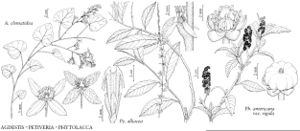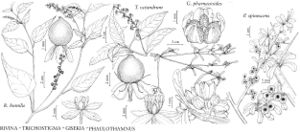Herbs, subshrubs, shrubs, trees, or vines, annual or perennial. Leaves alternate, opposite, or appearing whorled; stipules minute or absent; blade pinnately veined, margins entire, often undulate. Inflorescences axillary, terminal, or leaf-opposed spikes, racemes, panicles, or compound dichasia; bract 1; bracteoles 2. Flowers hypogynous (epigynous in Agdestis), radially symmetric; sepals usually persistent, 4–8, imbricate in bud, often unequal; petals absent; stamens 4–30[–100], sometimes borne in 1–2 whorls on hypogynous disk; gynoecium 1–12[–18]-carpellate, the carpels connate or distinct; ovaries superior (inferior in Agdestis), 1–12[–18]-locular; placentation basal; ovules 1 per locule; styles distinct (connate in Agdestis). Fruits achenes, berries, or cypselas. Seeds: perisperm present; embryo curved. x = 9.
Distribution
Temperate, subtropical, and tropical North America, West Indies, Central America, South America, Asia, Africa, Pacific Islands (Hawaii), Australia.
Discussion
Genera 18, species ca. 135 (6 genera, 11 species in the flora).
Delimitation of the Phytolaccaceae has long been a matter of debate. The circumscription of the family followed here, except for the inclusion of Gisekia, parallels that of J. W. Nowicke (1969). In narrower concepts, such as that of G. K. Brown and G. S. Varadarajan (1985), which rely heavily on chromosome and distribution data, six segregate families are recognized, those of concern for the flora being Phytolaccaceae sensu stricto (Gisekia, Phytolacca), Petiveriaceae (Petiveria, Rivina, Trichostigma), and Agdestidaceae (Agdestis).
A. Cronquist (1981) wrote that “each of the several segregate families … appears to be a natural group, but collectively they all hang together with the rest of the Phytolaccaceae. I see no reason why they cannot be accommodated at the level of tribes or subfamilies.” For Agdestis, recent anatomical data support Cronquist’s assertion, favoring the retention of the genus as a monogeneric subfamily within Phytolaccaceae sensu lato (S. Carlquist 1999). Wood and stem data do not strongly support separation of Petiveria and Rivina from Phytolaccaceae (S. Carlquist 1998).
The manifold folk medicinal uses of our genera (except Agdestis and Gisekia) are summarized in J. F. Morton (1981).
Phaulothamnus, included in Phytolaccaceae by some authors, is treated in the flora in Achatocarpaceae [see page 12].
Selected References
Lower Taxa
Illustrations
Key
| 1 | Carpels more than 1, distinct; fruits achenes | > 2 |
| 1 | Carpels 1, or if more than 1, united at least halfway by their ovaries; fruits achenes, berries, or cypselas | > 3 |
| 2 | Carpels and stamens 5; plants annual; leaves opposite or seemingly whorled; inflores- cences compound dichasia | Gisekia |
| 2 | Carpels and stamens more than 5; plants perennial; leaves alternate; inflorescences ax- illary, terminal, or leaf-opposed racemes or spikes | Phytolacca |
| 3 | Inflorescences panicles; ovary inferior; fruits cypselas crowned by winglike sepals | Agdestis |
| 3 | Inflorescences compound dichasia (appearing umbelliform), spikes, or racemes (proximalmost pedicels sometimes bearing more than 1 flower); ovary superior; fruits berries or, achenes, not crowned by winglike sepals | > 4 |
| 4 | Fruits elongate-cuneate achenes, apically 2-lobed, each lobe tipped with 1-3 sharply reflexed spines; inflorescences virgate spikelike racemes; ovary 1-carpellate | Petiveria |
| 4 | Fruits berries; inflorescences racemes (proximalmost pedicels sometimes bearing more than 1 flower in Phytolacca), not virgate; ovary 1- or more carpellate | > 5 |
| 5 | Carpels and styles 6-12; sepals 5(-8) | Phytolacca |
| 5 | Carpel 1; style absent or 1; sepals 4 | > 6 |
| 6 | Stamens 4; style present; stigma capitate; berries red to orange or yellow | Rivina |
| 6 | Stamens 8-13; style absent; stigma penicillate; berries black | Trichostigma |

